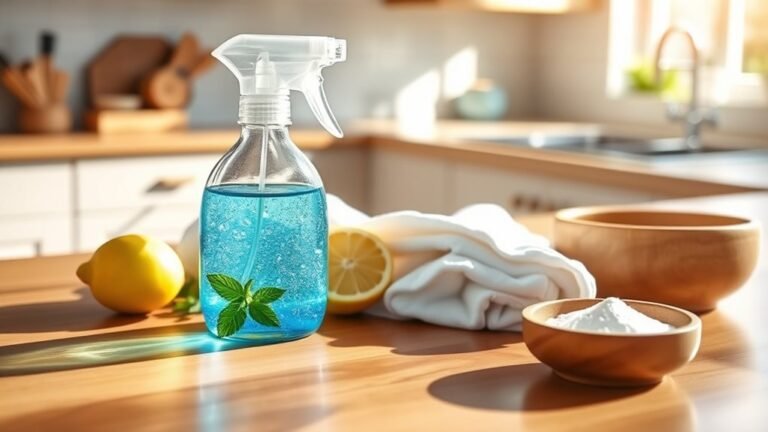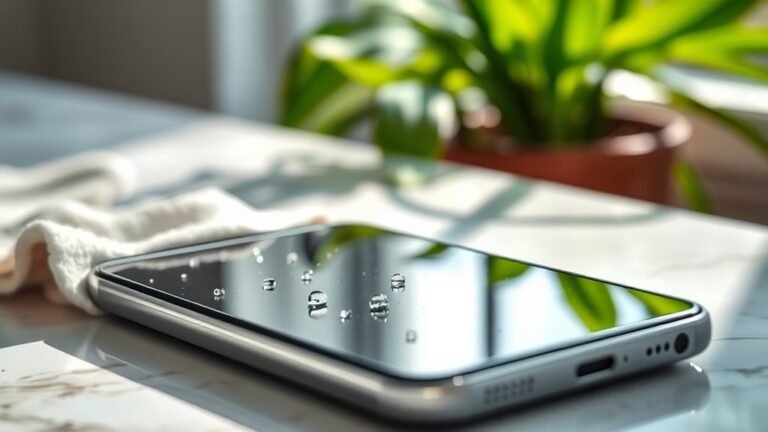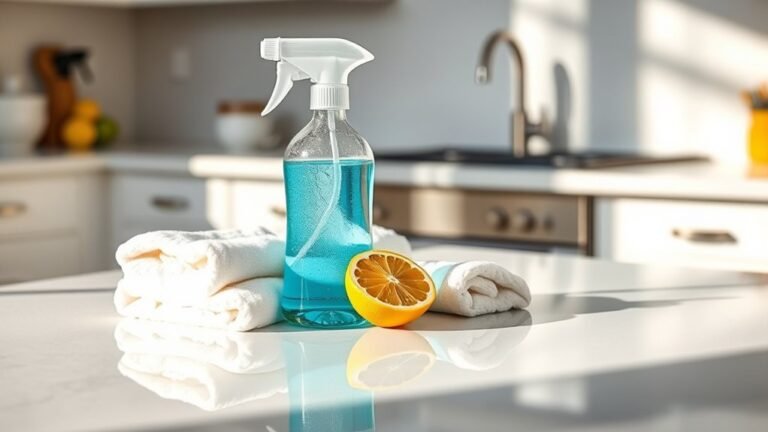How to Clean Your Smartphone Without Damaging It
To clean your smartphone without damaging it, first power it off and gather soft microfiber cloths and a 70% isopropyl alcohol solution or distilled water. Lightly dampen the cloth—never spray directly on your phone—and gently wipe the screen and surfaces. Use a soft brush for buttons and ports, avoiding excess moisture. Steer clear of harsh chemicals or abrasive materials to protect coatings. Keeping a regular weekly routine helps maintain hygiene and device longevity. There’s more you can do to keep your phone spotless and safe.
Gather the Right Cleaning Supplies

Before you start cleaning your smartphone, you’ll want to make certain you have the right supplies on hand. Choosing proper cleaning tools guarantees you don’t risk damaging your device while freeing it from germs and smudges. Opt for soft microfiber cloths that won’t scratch your screen, and avoid abrasive materials. Use safe materials like distilled water or a mixture of 70% isopropyl alcohol diluted with water—these effectively disinfect without harming sensitive surfaces. Steer clear of harsh chemicals or household cleaners that can strip protective coatings. Having a small, gentle brush can help clear dust from ports and crevices without forcing debris further in. By gathering these appropriate cleaning tools and safe materials, you maintain your device’s longevity and keep it pristine, letting you enjoy a clean, unrestricted smartphone experience.
Power Off Your Device Before Cleaning
Once you’ve gathered your cleaning supplies, the next step is to power off your smartphone. This simple action is vital for power safety, preventing any accidental taps or electrical issues while you clean. Turning off your device guarantees you won’t disrupt any ongoing processes, and it protects sensitive internal components from potential moisture or static damage. By powering down, you’re also contributing to your device’s longevity, as it reduces unnecessary stress on the hardware. Remember, cleaning a powered-on phone increases risks that can shorten its lifespan. So, take a moment to switch it off—this small step gives you the freedom to clean confidently, knowing you’re safeguarding your smartphone against harm and extending its useful life.
Use a Microfiber Cloth for Screen Cleaning

You’ll want to use a microfiber cloth to clean your smartphone screen because it’s gentle and effective at removing smudges without scratching. Make sure to wipe in gentle, circular motions to avoid damage. Avoid using paper towels or rough fabrics that could harm the screen’s surface.
Benefits of Microfiber Cloth
A microfiber cloth is one of the best tools you can use to clean your smartphone screen safely and effectively. Its microfiber benefits go beyond just wiping away smudges—it offers superior cleaning efficiency without damaging your device. Here’s why you’ll want one:
- Gentle on Screens – Microfiber cloths clean without scratching or wearing down your screen’s protective coating.
- Traps Dirt and Oils – The fine fibers capture dust, fingerprints, and oils better than regular cloths.
- Reusable and Durable – You can wash and reuse microfiber cloths multiple times, giving you freedom from waste.
- No Chemicals Needed – They clean effectively with just water, letting you avoid harsh cleaners that could harm your phone.
Using a microfiber cloth gives you control and confidence in keeping your smartphone clear and safe.
Proper Cleaning Technique
Two key steps make cleaning your smartphone screen with a microfiber cloth both safe and effective. First, always use a dry or slightly dampened cloth to avoid excess moisture. Second, gently wipe in circular motions to lift screen smudges without scratching. To keep your screen clear and your freedom intact, adjust your cleaning frequency based on usage—daily if you’re always on the go, or a few times a week otherwise.
| Step | Description |
|---|---|
| Prepare Cloth | Use a clean, dry microfiber cloth |
| Wipe Gently | Circular motions, no harsh pressure |
| Adjust Frequency | Clean as needed based on smudges |
Following these steps guarantees a spotless screen without risking damage, so you stay connected freely.
Avoiding Screen Damage
When cleaning your smartphone screen, using a microfiber cloth is key to avoiding damage. Unlike rough materials, microfiber gently lifts dirt without scratching your screen or compromising screen protectors. This helps maintain your device’s touch sensitivity, so you won’t lose that smooth, responsive feel.
Follow these steps for safe cleaning:
- Choose a clean, dry microfiber cloth.
- Wipe the screen with light, circular motions.
- Avoid pressing hard to protect the screen protector.
- Don’t use paper towels or abrasive fabrics that can leave scratches.
Apply Cleaning Solutions Safely

Before applying any cleaning solution, you’ll want to make certain your smartphone is turned off and unplugged. This simple step protects your device from accidental damage and gives you the freedom to clean without worry. When choosing cleaning solutions, opt for gentle, alcohol-free options designed for electronics to guarantee safe application. Never spray or pour liquids directly onto your phone; instead, lightly dampen a microfiber cloth with the solution. This approach prevents excess moisture from seeping into sensitive areas. Gently wipe the screen and surfaces, avoiding harsh scrubbing that could harm coatings. By following these steps, you maintain your smartphone’s integrity while enjoying the freedom to keep it spotless. Safe application is key—respect your device and clean smartly.
Clean Around Buttons and Ports Carefully
When cleaning around your phone’s buttons and ports, use a soft brush to gently remove dirt without causing damage. Make sure to avoid getting excess moisture inside these areas to prevent any issues. Taking these precautions helps keep your device safe and functional.
Use Soft Brushes
A soft brush can be your best tool for cleaning around your smartphone’s buttons and ports without causing damage. Choosing the right brush type, like a small paintbrush or a soft-bristled toothbrush, lets you reach tight spots effortlessly. Maintaining a regular cleaning frequency keeps grime from building up and affecting your phone’s performance. Here’s how to use soft brushes effectively:
- Select a brush with gentle bristles to avoid scratching surfaces.
- Brush lightly around buttons and inside ports to dislodge dust and debris.
- Clean your brush regularly to prevent spreading dirt back onto your phone.
- Schedule cleaning sessions based on your usage and environment—for example, once a week if you’re often outdoors.
This approach gives you freedom to keep your phone pristine without risking damage.
Avoid Excess Moisture
Someone might think that using plenty of liquid is the best way to clean your smartphone, but you’ll want to avoid excess moisture, especially around buttons and ports. Water exposure here can cause moisture damage, leading to malfunctions or corrosion. Instead, lightly dampen a cloth and gently clean these areas. Use a dry cotton swab or soft brush to reach tight spots without letting liquid seep inside.
| Area | Cleaning Tip |
|---|---|
| Buttons | Use a barely damp cloth; dry fast |
| Charging Port | Blow out dust; avoid liquids |
| Speaker Grills | Soft brush; no direct moisture |
Taking these steps guarantees your phone stays clean without risking damage, giving you freedom to enjoy your device worry-free.
Avoid Harsh Chemicals and Abrasive Materials
Because harsh chemicals and abrasive materials can damage your smartphone’s screen and coating, you should steer clear of them during cleaning. Choosing the right chemical alternatives and considering the materials you use is essential to keep your device safe and fully functional.
- Avoid bleach, ammonia, and alcohol-based cleaners, as they can strip protective coatings.
- Opt for gentle chemical alternatives like diluted soap or screen-safe sprays.
- Skip abrasive materials like paper towels or rough cloths; microfiber cloths are your best friends.
- Be mindful of pressure; scrubbing hard can scratch or wear down the surface.
Maintain Regular Cleaning Habits
While it might seem tedious, maintaining regular cleaning habits is key to keeping your smartphone hygienic and functioning well. You don’t have to clean it obsessively, but setting a consistent cleaning frequency—like once a week—helps prevent grime buildup and reduces germs. Remember, the hygiene importance of this routine goes beyond just appearance; it protects you from bacteria that accumulate on your device daily. By making cleaning a simple habit, you’re taking control of your health without feeling restricted. Keep it quick and straightforward: a gentle wipe with a microfiber cloth and a safe disinfectant will do. Staying consistent means your phone stays fresh, letting you enjoy the freedom of a clean device without hassle or worry.
Frequently Asked Questions
Can I Use Disinfectant Wipes on My Smartphone Screen?
You might be wondering if disinfectant wipes are safe for your smartphone screen—here’s the catch. While disinfectant wipes can kill germs effectively, not all are safe for your screen protection. You’ve got to use wipes that are alcohol-free and designed for electronics to avoid damaging the coating. So, before you grab that wipe, check the label—it’s all about keeping your phone clean without sacrificing the freedom of a flawless screen.
How Often Should I Deep Clean My Smartphone?
You should aim for weekly maintenance to keep your smartphone fresh and germ-free without overdoing it. Using gentle cleaning products designed for electronics helps protect your device while effectively removing grime. Deep clean more thoroughly once a month or when it’s visibly dirty, but stick to safe solutions to avoid damage. This way, you stay in control and free from worries about harming your phone while keeping it spotless.
Is It Safe to Use Compressed Air to Clean Ports?
Imagine you’re clearing dust from your headphone jack with a can of compressed air but accidentally spray too close, pushing debris further inside. Compressed air safety is vital here; always hold the can upright and keep a slight distance to avoid moisture buildup or damage. For effective port cleaning techniques, use gentle bursts rather than continuous spray. This way, you maintain freedom to clean confidently without harming your device’s sensitive components.
Can Water Damage My Smartphone During Cleaning?
Yes, water exposure can definitely damage your smartphone if you’re not careful. You don’t want water seeping into ports or openings during cleaning. Instead, stick to gentle cleaning techniques like using a slightly damp microfiber cloth or specialized electronics wipes. Avoid spraying water directly on your device. With the right approach, you can keep your phone fresh without risking any harmful water damage. Stay free to clean smartly!
What Should I Do if My Smartphone Gets Wet?
If your smartphone takes an unexpected swim, don’t panic. Water damage can be tricky, but you’ve got options. First, power it off to avoid short circuits. Skip the hairdryer’s fierce blast; instead, embrace gentler drying methods like placing it in a bowl of uncooked rice or silica gel packets to draw out moisture. Give it time—freedom means patience—and soon your device might just bounce back to life.






